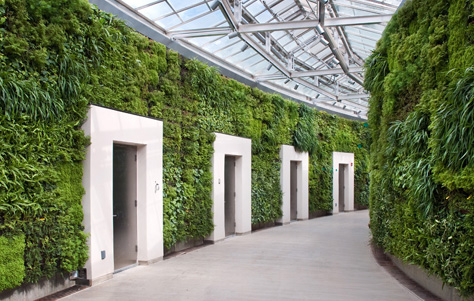That plant wall is freaking gorgeous, my friend. Just... wow.
It's got 7x 350 lumen daylight LEDs hitting it. My father in law, the master gardener, thinks it won't get enough light. It's getting 50 foot candles, or 538 lumens/m^2, out of 2450 lumens. On eBay right now there are fixtures that will fit the track that take 250W quartz lamps. 5700 lumens each. I could fit three easy. That should get me about 350 foot candles. So the question is: do I let go of the low-energy utopia of LED MR16s and hang three torchiere lamps? I think yes.
Seems like the light is a bit low for what you need. The problem is that if you hit them with the amount they need for good growth its too bright and blinds you and/or you end up with a weird color spectrum (pink/blue lights). In living areas you almost need to have them setup as inverse proximity sensors where they turn on when nobody is there to be annoyed by the bring lights. One trick I've seem for places that do plant walls but dont have enough lights is that they rotate the plants in and out every week or two. You have a place setup off-site that has brighter lights and you grow the plants there for a bit and then move them back into your decorative locations. Its a pain in the ass but it can be done effectively. My favorite lights are Metal halide, they aren't as efficient as HPS for plant growth but you get one with a wide natural color spectrum. When I had one setup for the indoor Tomatoes I'd just sit under it on rainy days and it would genuinely make me feel happier. You get around 75-100 Lumens/Watt which is close to what you get in high end LEDs (CREE, Philips) and better than Chinese LED's. The problem is how you incorporate them into you design at this point.
I've always loved MH for aquariums. They're the only way to get the scintillation on the gravel. But they're pigs. They put out a shit-ton of heat. they're fragile. They're short-lived. And they're definitely not sitting on Gemini track. The pink/blue thing is a problem too because none of the grow lights have any kind of throw. They expect you to be growing tomatoes with a light hanging horizontally six inches from above. And nobody who does grow lights expects you to do any flagging - it's gonna be hella bright, it's gonna have a 360 degree pattern, and there will be zero facility to control the spread. Believe it or not, I threw a PAR meter on the thing. With 14 hours of on-time the wall gets more than 2 and less than 50 PAR. I actually did just fine with some exemplar plants over a year ago: The nice thing about having it on the wall 4' up is I can hit it obliquely and never hit anyone in the eyes.
Id love to see how you experiment turns out. Ive wanted to do something similar with built in plants but always thought it would be too impractical given the lighting thats currently available. There isnt a lot of documentation online about low light plants like the ones you have so it will be interesting to see if that you give them is enough
The moss is already spreading. The prayer plants are popping out leaves. The pothos are shooting out leaves, too, with some white to them. Even the Ludisias seem to be doing okay... the Spiders, though, are unmoved. We'll see. The water is on a tap under the sink, which goes to a drip irrigation line along the top. The intent is to slap a solenoid on there, and then put a timer on the solenoid. Bonus points if I can get a doser in there too for some liquid fertilizer because otherwise, fertilizing the thing is gonna be tricky. I wish I could call it an experiment. 80% of the installed green walls in the world use that system or the outdoor version.

